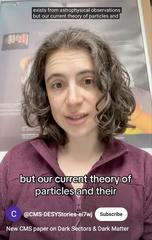Scientist Juliette Alimena explains the comprehensive search for dark matter in a YouTube video. Video: CMS DESY
Dark matter must be out there somewhere, in some form or other. Are as yet undiscovered particles its constituents or is it much more complicated than that? Scientists from DESY and other institutions working in the CMS collaboration at CERN’s Large Hadron Collider LHC, the largest particle accelerator in the world, have put together everything they know in one comprehensive paper. Spoiler: they have not found dark matter, but this overview will play a key role in tracking it down eventually. In a video produced by CMS-DESY, Juliette Alimena, a scientist in the CMS group at DESY and head of the study, explains what they have been working on.
Click here to watch the YouTube short (external link)
“In some theories, dark matter isn’t just a new particle – it could be part of a whole dark Universe,” says Juliette Alimena. “This could be as complicated in its structure and interactions as our own. Our summary paper offers new insights and hints at where to look next.”
The CMS Collaboration has probed a variety of theoretical models in these searches for dark matter, which can be grouped into different families. In dark matter models, at least one dark matter particle is introduced. In addition, there is a “mediator” particle that governs the interaction between the dark particles in the “dark sector” and the particles in the standard model, which are the ones that make up all the visible matter in the universe. There are two major classes of models used in CMS searches for dark matter: “Simplified Dark Sectors”, which involve a single mediator particle, and “Extended Dark Sectors”, which have more complicated structures. Within each of these classes, scientists studied many specific dark-matter models studied, including axion-like particles (ALPs), dark Higgs bosons, hidden valleys, particular versions of supersymmetry (SUSY), and hidden abelian Higgs bosons.
Each search for dark matter probes a different kind of event or signature in the detector. In general, these can be invisible, prompt and visible, or long-lived. Invisible signatures are common in searches for dark matter because, in its simplest form, dark matter should be electrically neutral and not interact in the CMS detector, making it invisible. However, if scientists can produce a mediator in the proton collisions this mediator could also decay into Standard Model particles. This is how “visible” signatures can be sought with CMS data. These signatures can be “prompt” or “long-lived”; some models predict particles that decay immediately and produce “prompt” signatures in the detector, while other models predict particles that travel some distance within the detector before decaying and producing “long-lived” signatures. “If the particles have long lifetimes, we must be particularly creative in elaborating the corresponding searches, as these long-lived particles often require special techniques to reconstruct their flight paths within the detector,” explains Jeremi Niedziela, a postdoc in the CMS group at DESY.
The basis for some new interpretations are theoretical models called “hidden valleys.” They predict multiple new forces and particles that often “hide” in a “valley” and could become accessible at high LHC collision energies. These models predict several new types of signatures, some prompt, some long-lived, and CMS physicists have now interpreted several existing analyses in these new models.
The review paper presents the results of a wide range of searches in CMS for dark matter, covering a wide range of dark matter masses and other intrinsic properties. There has been no sign of dark matter yet but this paper helps to map out what has been done and gives physicists important guidance regarding where they should hunt next.
Original publication:
“Dark sector searches with the CMS experiment”, the CMS collaboration








